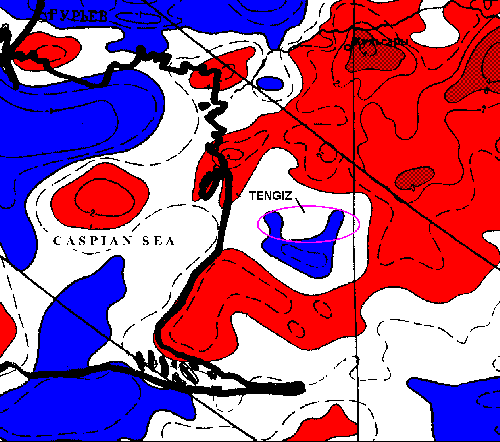
by
Richard I. Gibson
Gibson Consulting
Presented at Society of Exploration Geophysicists meeting in Moscow, July 1992
Tengiz Field occupies an immense Late Paleozoic carbonate buildup in the eastern part of the North Caspian Basin. The basement in the eastern part of the basin is inferred from its magnetic character to be shallower than, or of fundamentally different composition from the central and western portions of the basin, or both. A distinct magnetic terrane, herein called the East Caspian Craton, lies between the deep central portion of the North Caspian Basin and the Ural Fold Belt. This terrane is similar in its magnetic character to cratonic terranes in other parts of Eurasia, North America, and elsewhere. It has sharp boundaries and may represent either a microcontinent or a mechanically separate block within the Eastern European Craton. Most of the magnetic variations within this terrane are relatively high-intensity anomalies (a few hundred nanoTeslas), indicative of major lithologic changes in the inferred cratonic basement.

Small frequency variations in published magnetic data at Tengiz Field suggest that the carbonate buildup there was constructed upon a basement uplift. Interestingly, the main magnetic anomaly at Tengiz is a low, signifying that the basement there is of lower magnetic susceptibility than in adjacent areas, but the higher frequency of the anomalies indicates somewhat shallower depth. The depth break is interpreted as a NE-SW trending basement fault block, although the data are inadequate to define orientation precisely.
Five analogs to the interpreted basement fault at Tengiz have been inferred from the magnetic data within the East Caspian Cratonic terrane. One of these is at Zhanazol Field, like Tengiz a subsalt accumulation of hydrocarbons; the others are apparently not productive or are untested. The role of the basement in guiding reef buildups in the eastern part of the North Caspian Basin appears to be significant, and can be defined in at least a preliminary manner using magnetic data.
It is not possible to make an unequivocal interpretation of the magnetic data at Tengiz Field, in part because of the great depth to magnetic basement. This interpretation and the inferred analogs are a conceptual starting point for more detailed analyses, using higher-quality data displayed at larger scales.
You may also be interested in our Custom Bibliography of the North Caspian Basin, covering nearly 500 articles in English from the journal Petroleum Geology. In addition, we offer a digital database of the oil and gas fields of the North Caspian Basin derived from information in Maksimova (1987).
Back to Abstracts Index
Back to Former Soviet Union Index
Back to Custom Bibliography page
Back to Rapid Research Projects
|